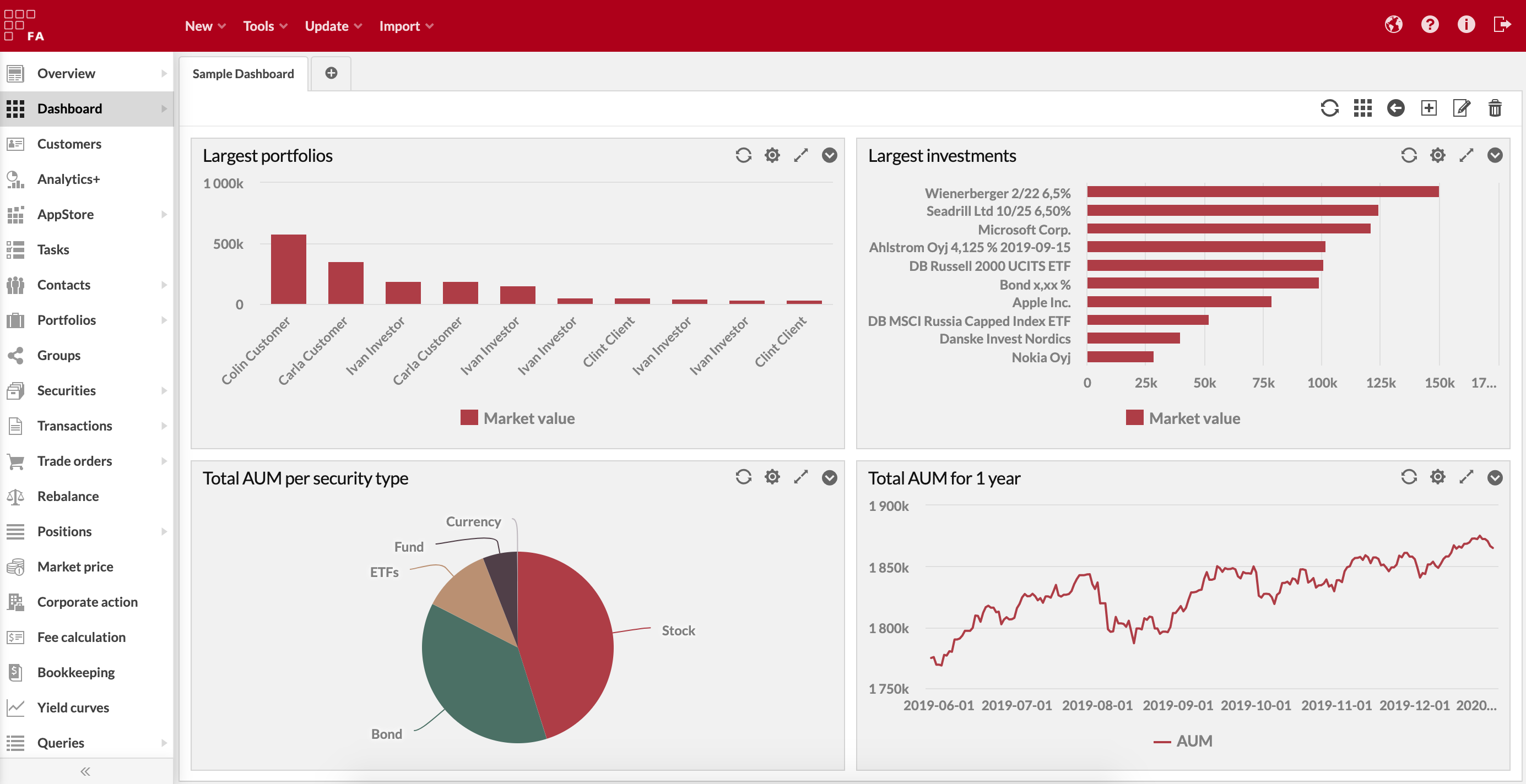Dashboard view
The Dashboard as the landing page for FA allows you to view the most relevant information directly when logging in to FA. Each FA user can define their own dashboard and own landing page out of the information stored in FA. Customized and personal dashboards ensure that you will be able to directly access the information most relevant to you when logging in or when accessing the Dashboard. See also Set up a dashboard for detailed steps on managing your dashboards.

Managing the entire dashboard
To manage the entire dashboard, use the following features available at the top-right corner of the Dashboard view:
Saving dashboards
 . Once you have defined a dashboard, you can save it for later useuse. Whenever you have defined a new dashboard, remember to save it in order for it to be available for you when you return to the Dashboard.
. Once you have defined a dashboard, you can save it for later useuse. Whenever you have defined a new dashboard, remember to save it in order for it to be available for you when you return to the Dashboard.Selecting a default dashboard
 . Once you have defined a dashboard, you can use as your landing page. The default dashboard's content is always shown when you access the dashboard.
. Once you have defined a dashboard, you can use as your landing page. The default dashboard's content is always shown when you access the dashboard.Modifying the layout for your dashboard
 . By default, a dashboard layout is set to 2x2, or to four sections of the same size. You can select a different layout for your dashboard, consisting of either 3 or 4 sections of different sizes. You can choose the layout from 1, 2x2, 2x1, 1x2, or 3x1 - try out different layouts to get the most out of the content of the sections you have selected.
. By default, a dashboard layout is set to 2x2, or to four sections of the same size. You can select a different layout for your dashboard, consisting of either 3 or 4 sections of different sizes. You can choose the layout from 1, 2x2, 2x1, 1x2, or 3x1 - try out different layouts to get the most out of the content of the sections you have selected.Refreshing the content of your dashboard
 . Refreshing the dashboard allows you to see the latest and up-to-date content within all the sections of your dashboard, to take into account changes someone else might have made in the background.
. Refreshing the dashboard allows you to see the latest and up-to-date content within all the sections of your dashboard, to take into account changes someone else might have made in the background.
Managing individual widgets
To manage individual section, or widgets, on your dashboard, utilize the following features available at the top right-hand corner of each widget:
Selecting the content of widgets. For each individual section on your dashboard, select the content you want to view from the downward arrow icon  on the top right-hand corner of the widget. You can choose from:
on the top right-hand corner of the widget. You can choose from:
Empty widget, or an empty section on your dashboard.
Widgets defined in Preference. Widgets allow you to extend and customize the content available on a section on the dashboard - contact FA for more details about custom widgets.
Any of your saved searches on the search views. Any of the searches you have saved on any of the search views are selectable as content for your dashboard. The saved searches are listed as View name: Tab name, allowing you to easily identify the search you want to select on your dashboard. Whenever accessing the dashboard, you are presented with latest and up-to-date search result on your search-based widget. To get more content available for your Dashboard, just save a new search on any of your search views to select it for your dashboard.
Queries saved in the Queries view. Saved queries are listed as other saved searches as Queries: Query name, allowing you to easily identify the query you want to select on your dashboard.
Tasks widget, or a task list for you to view and manage your tasks.
Maximizing widgets. Maximizing a widget with the maximize icon  allows you to view the contents of the selected widget as a full-screen window. When maximizing a search-based widget, you are also able to use all the buttons and other functionality available for you in the corresponding search view.
allows you to view the contents of the selected widget as a full-screen window. When maximizing a search-based widget, you are also able to use all the buttons and other functionality available for you in the corresponding search view.
Configuring widgets. Configuring widgets through the configuration icon  allows you to change the name of your widget and to configure the format of your widget (only available for query-based widgets). Query-based widgets allow you to view the results of your query as different graphs - select the graph you want to use from the Format field, and define the contents of your graph in the Label and Value(s) fields.
allows you to change the name of your widget and to configure the format of your widget (only available for query-based widgets). Query-based widgets allow you to view the results of your query as different graphs - select the graph you want to use from the Format field, and define the contents of your graph in the Label and Value(s) fields.
Refreshing the content of a widget. Refreshing a widget through the refresh icon  allows you to see the latest and up-to-date content within your widget, to take into account changes someone else might have made in the background.
allows you to see the latest and up-to-date content within your widget, to take into account changes someone else might have made in the background.